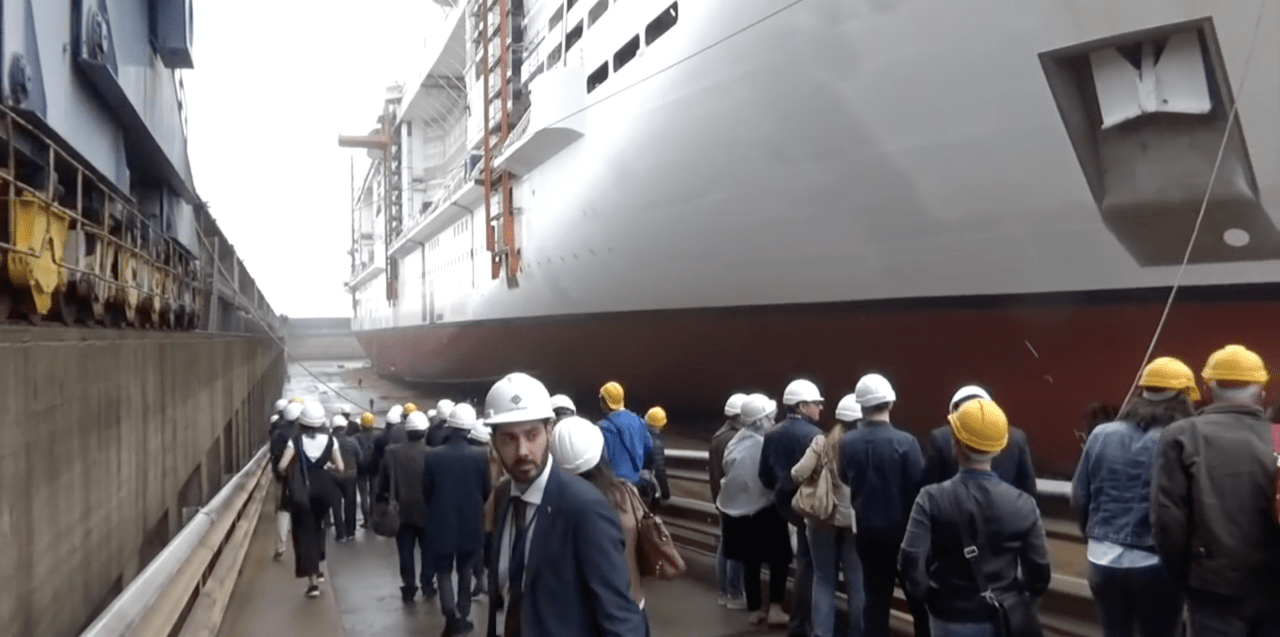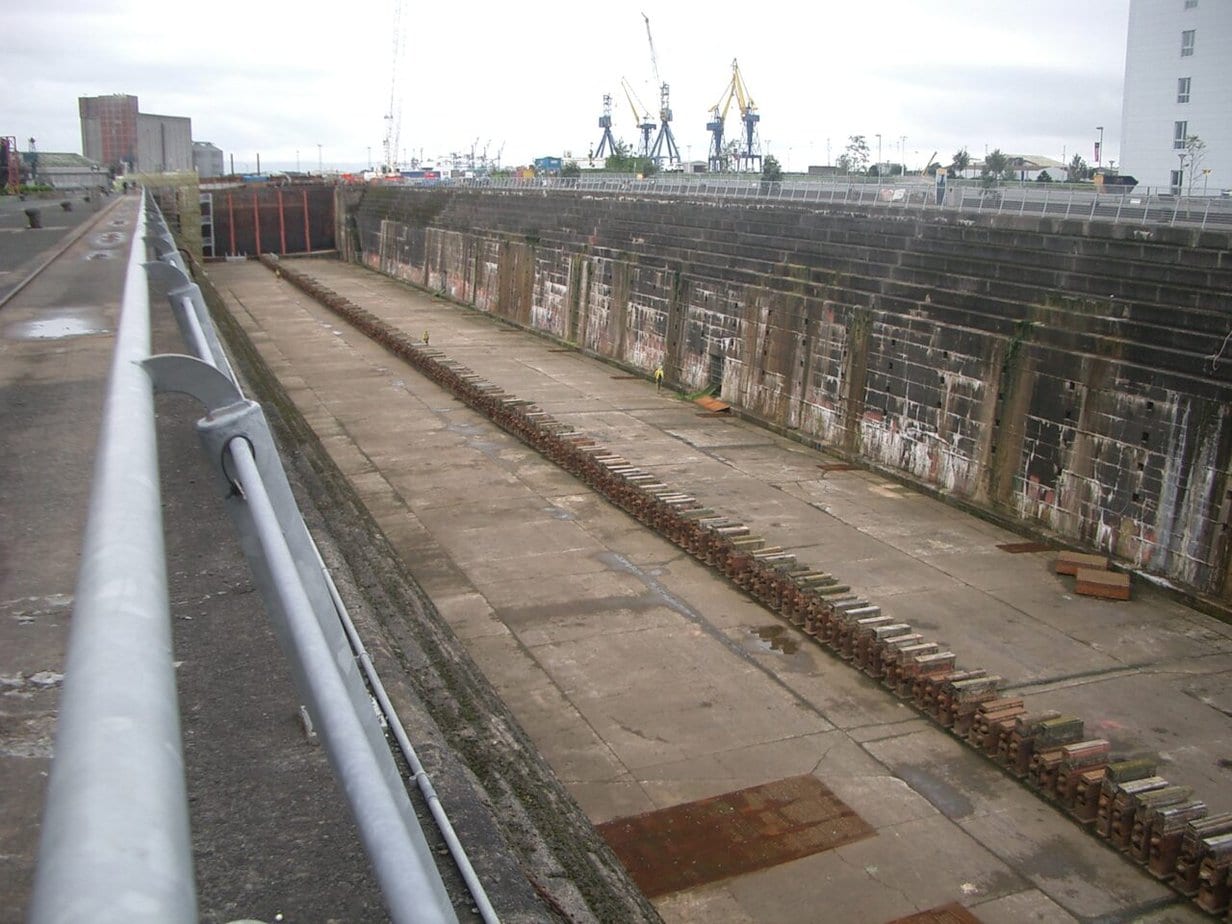Cruise ships need regular maintenance to make sure they are safe, sail efficiently and are up to date with rules and regulations.
Sometimes, maintenance requires the ship to be put in a dry dock. But what exactly is a dry dock, and why do cruise ships need them?

What Is A Dry Dock?
A dry dock is a specialised facility where ships are taken out of the water so that maintenance, repairs, and inspections can be carried out on areas that are normally underneath the water.
There are two primary types of dry docks – floating dry docks and graving docks.
- Floating Dry Docks
- These are movable structures that are flooded to submerge and allow the ship to enter.
- Once the ship is positioned, the dock is drained, raising the vessel out of the water.
- Graving Docks
- These are permanent, basin-like structures that are flooded to allow the ship to float in.
- Once in position, the water is drained, leaving the ship dry and accessible for work.
A dry dock provides access to parts of the ship that cannot be reached while it is in the water – such as the hull, propellers, and rudders.
This is essential for keeping the ship in a good working condition.
Why Do Cruise Ships Need Dry Docks?
Dry docks are necessary for cruise ships for several reasons:
- Structural Inspections
- The hull and other submerged parts of the ship are subject to wear and tear from water, marine life, and other environmental factors.
- Dry docking allows inspectors to check for damage or corrosion and carry out necessary repairs.
- Routine Maintenance
- This includes cleaning and repainting the hull to reduce drag and improve fuel efficiency.
- During dry dock periods, in-water components, such as propellers and stabilisers, can also be inspected and serviced.
- Mechanical Overhauls:
- Cruise ships rely on a range of mechanical systems to operate.
- Engines, propellers, and stabilisers may require significant maintenance or replacement. This can only be done when the ship is in a dry dock.
- Compliance with Maritime Regulations
- International maritime laws require ships to undergo regular inspections and maintenance to meet safety and environmental standards. Dry docking is a necessary part of this process.
- Upgrades and Refurbishments
- Cruise lines often use dry docking to refurbish ships. This may involve upgrading cabins and adding new restaurants or entertainment venues.
- Some cruise ships have actually been lengthened and had an extra section added in the middle to provide more cabins – which equates to more profits for the cruise line.
- These improvements help to keep the ship modern and appealing to passengers.
- Environmental Requirements
- Many cruise lines are increasingly focused on environmental sustainability.
- During dry docking, ships can be fitted with new technology, such as scrubbers, which reduce harmful emissions and make the ship more eco-friendly.
Watch a cruise ship being “lengthened” to add more cabins in the video below:
How Often Do Cruise Ships Go to Dry Dock?
Cruise ships typically undergo scheduled dry docks every 2-3 years, depending on the ship’s age, condition, and the specific needs of the cruise line.
In some cases, ships may also enter dry docks on an emergency – if unexpected repairs are needed or if the ship has been involved in an accident.
What Happens If Ships Don’t Undergo Dry Dock?
If the ship doesn’t regularly go into dry dock, it can result in significant issues.
Structural problems, such as hull damage, can go unnoticed and worsen over time.
Mechanical systems that are not properly maintained can fail, leading to delays, breakdowns, or even safety risks for passengers and crew.
That is the last thing the cruise line wants. It can be costly for them if they have to give compensation to passengers because of problems on their cruise.
Ships that don’t meet regulatory standards may face fines or be immediately taken out of service.
I booked a cruise on an older ship, but before we even sailed away, the cruise was cancelled because the ship failed an important safety check.
This was costly for the cruise line, as they had to refund all the passengers, and it also had the knock-on effect of damaging the cruise line’s reputation.
Find out what happened here:
Skipping dry dock can also affect a ship’s fuel efficiency and increase operating costs.
The buildup of marine growth on the hull can increase drag, leading to higher fuel consumption.
Find out more about how they prevent marine growth on the hull of the ship here:
Why Are Ships Red Below The Waterline? – I Went Under One to Find Out!
Interesting Dry Dock Facts
- Some of the largest dry docks in the world can hold vessels over 300 meters long. They are essential for servicing these large cruise ships.
- Dry docks are highly efficient. During a typical dry dock period, crews work around the clock to complete extensive repairs and upgrades within a matter of weeks.
- During significant cruise ship refurbishments, entire sections of ships are reconfigured or expanded to improve the guest experience.
Specialist Dry Dock Crews
The ship’s normal maintenance crew is not responsible for the work carried out in the dry dock.
Cruise lines hire specialised contractors to maintain and upgrade their ships.
These may include naval engineers, painters, welders, and other skilled workers who focus on maritime repairs.
Crews often work 24/7 during dry dock periods to complete all the necessary tasks quickly.
This ensures the ship can return to sailing without lengthy delays, minimising the time the ship is out of service and enabling cruise lines to continue to make profits.
Costs Involved
Dry docking a cruise ship is expensive, with costs often ranging from $2 million to over $10 million, depending on the size of the ship and the extent of the work needed.
Costs cover everything from the labour and materials for repairs to port fees and logistical expenses.
While expensive, dry docks are considered an essential investment for cruise lines. A well-maintained ship operates more efficiently, attracts more passengers, and avoids costly breakdowns.
Neglecting a ship’s maintenance can lead to bigger expenses later on, so the cruise lines need to keep all their ships in good order.
Environmental Impact and Innovations
Dry docks play a critical role in improving a ship’s environmental performance.
Cruise lines are under increasing pressure to reduce their carbon footprint. During dry dock periods, they often install energy-efficient engines, exhaust gas cleaning systems (scrubbers), or ballast water treatment systems that minimize harmful discharges into the ocean.
These upgrades help ships comply with international regulations, such as the IMO’s (International Maritime Organisation) mandates on reducing sulfur emissions.
By upgrading in dry dock, cruise lines make sure they are legally compliant whilst demonstrating their environmental responsibility.

Notable Dry Dock Projects
Oasis of the Seas
Some cruise ships undergo significant transformations during dry dock, making them almost unrecognisable.
For example, Royal Caribbean’s Oasis of the Seas underwent a $165 million dry dock overhaul in 2019. The ship received new water slides, revamped cabins, and additional dining options.
These major projects often include adding new decks, completely overhauling public spaces, or installing entirely new technology, essentially transforming the ship into a newer, more modern version of itself.
These massive undertakings highlight just how important dry docks are for keeping ships competitive in a fast-evolving industry.
Unfortunately, whilst Oasis of the Seas was in dry dock, a large crane collapsed onto her at the Grand Bahama Shipyard.
This must have been extremely costly for Royal Caribbean, as she was out of service for longer than anticipated, and future guests had to be compensated.
Guests on the three sailings will receive full refunds, as well as full credit toward a future cruise
Royal Caribbean
Some cruise lines have actually cut their cruise ships in half when in dry dock so they can add an extra section with extra cabins. This helps them cost-effectively maximise profits.
Find out more here:
These Cruise Ships Were Cut in Half: Why and How (Royal, MSC, NCL & More)
How Cruise Lines Minimise Downtime
Cruise lines are constantly trying to reduce the amount of time a ship spends in dry dock to maximise its time in service.
To do this, they schedule dry docks during off-peak seasons when fewer passengers are cruising, such as in early spring or late autumn.
They also plan ahead and stockpile parts and materials to make sure that the work can start as soon as the ship enters the dock.
This minimises logistical delays. Additionally, some dry docks overlap routine maintenance with upgrades to complete both together.
Cruise lines often advertise the fact that the ship is going into dry dock for a major refurbishment.
It boosts sales, as guests are always keen to try out new or newly-refurbished ships.
What’s It Like Inside a Dry Dock?
Being inside a dry dock can feel surreal, especially for those used to seeing ships in the water.
Once drained, the massive hull of the ship is completely exposed, towering above the workers. This allows them to inspect areas like the propellers, rudders, and bow thrusters.

The scene is usually very busy, with workers, equipment, and scaffolding.
You might hear the sounds of welding, see workers re-coating the ship’s hull with anti-fouling paint, and see large components like engines or stabilisers being removed and replaced.
Dry docking is a carefully coordinated operation – and time is of the essence!
History of Dry Docks
The concept of dry docking ships dates back to ancient times.
The first known dry dock was built in the 15th century in Portsmouth, England, to maintain warships.
Over the centuries, dry docks have evolved to accommodate larger and more advanced ships.
In 2012, I visited Thompson Graving Dock at the Harland & Wolff shipyard in Belfast, where the Titanic was built. The sheer scale of the dry dock has to be seen to be appreciated.


Today, modern dry docks can handle the largest cruise ships, some of which are over 300 meters long and weigh more than 200,000 gross tons.
The advancements in dry dock technology reflect the increasing complexity of the ships they serve.
What Happens in Wet Dock vs. Dry Dock?
Wet docks are used when the ship is undergoing maintenance or minor repairs but remains afloat in the water.
Tasks like interior upgrades, electrical repairs, or non-critical engine work can be done in a wet dock without the need to actually remove the ship from the water.
A dry dock, on the other hand, is necessary when parts of the ship that are underwater need attention. This includes hull cleaning, propeller repairs, and installing new underwater technology.
Wet docks are less costly, but don’t allow for the extensive maintenance that a dry dock provides.
Guest Experience Post-Dry Dock
After a ship has undergone dry dock, passengers usually notice improvements in several areas.
Cabins may have been refurbished with newer decor, dining venues might be updated or entirely new, and entertainment options could be enhanced with new shows or facilities.
Cruise lines often market these post-dry dock upgrades to attract passengers, promoting the ship as “newly refreshed” or “refurbished.”
This creates a sense of excitement, especially for passengers who may have sailed on the ship before and are curious about the changes.
Before You Go
Find out why ships are usually referred to as “She” here:
The Real Reason Ships Are Called “She” – Language, History, and Myth
Find out how big the Titanic was in comparison to modern cruise ships here:
Titanic vs a Modern Cruise Ship Fleet – Comparison with Photos!

Free Insiders Cruise Line Guide
Ever wondered how the mainstream cruise lines compare? Cruise lines won’t tell you this, but I will.
This FREE guide shows you everything you need to know to find your perfect cruise line.
Whenever I take a cruise I order a print of my trip. It uses the real satellite data from the cruise and is always a great conversation starter!
I'm building an impressive collection...
Code EMMACRUISES will get you 10% off

